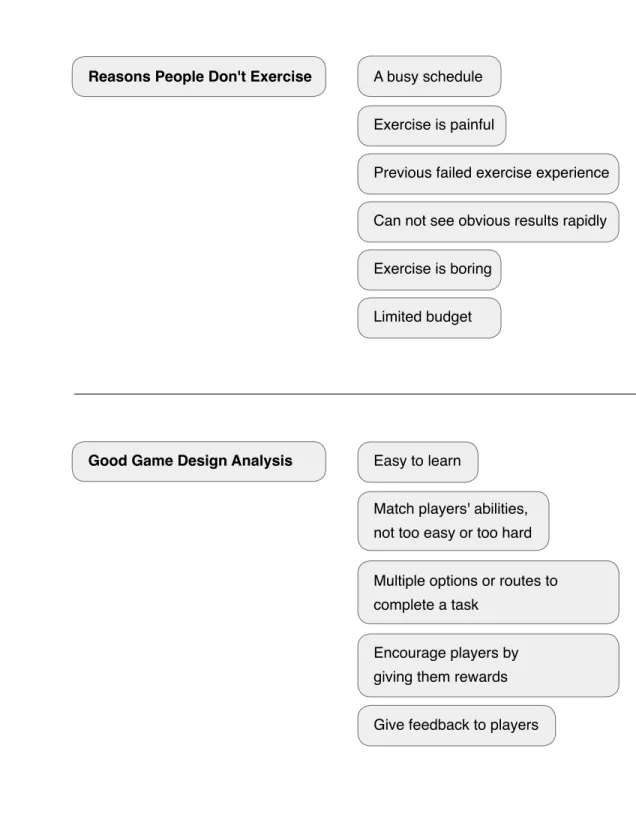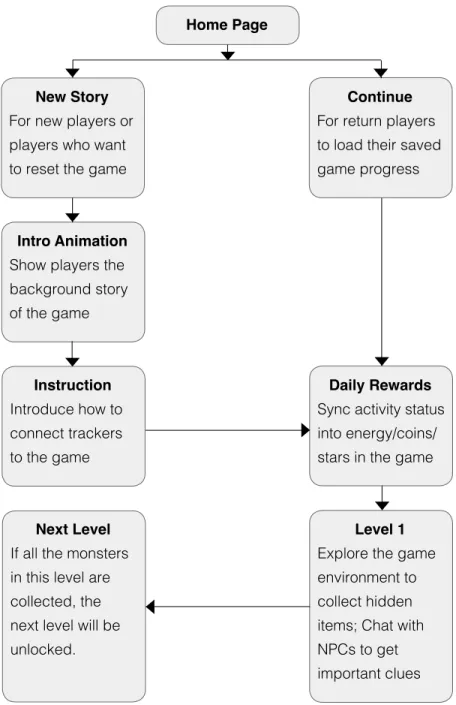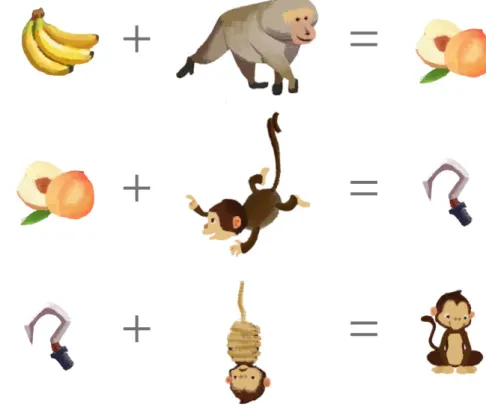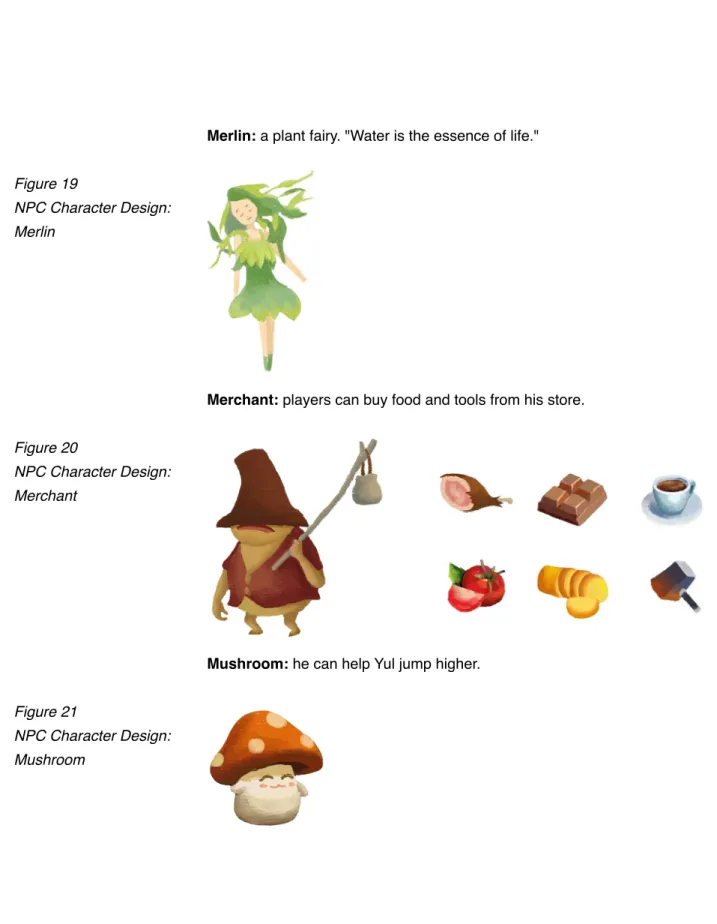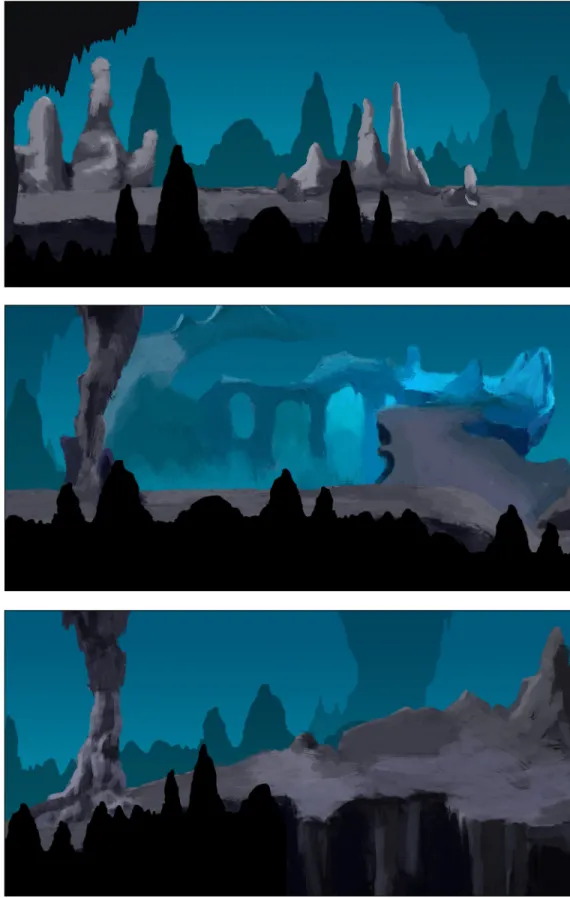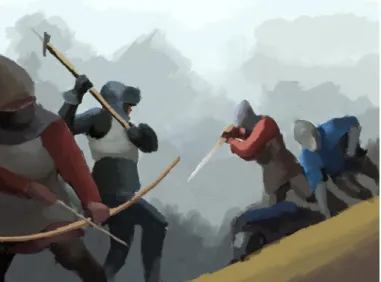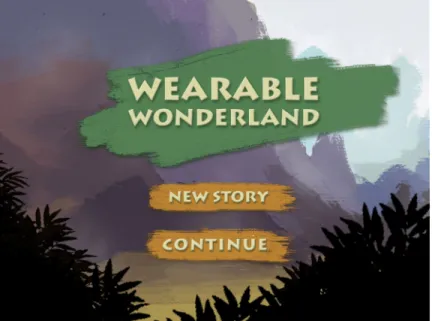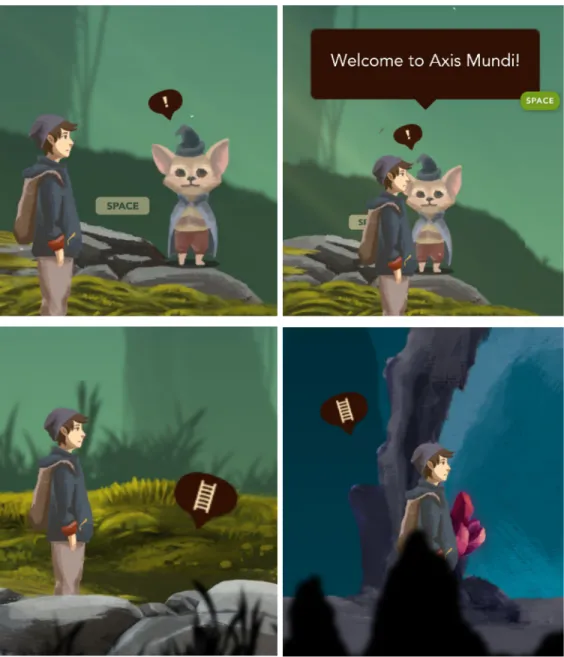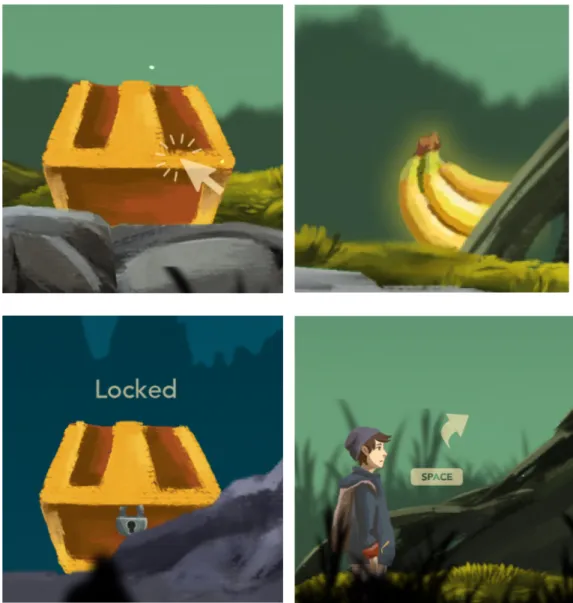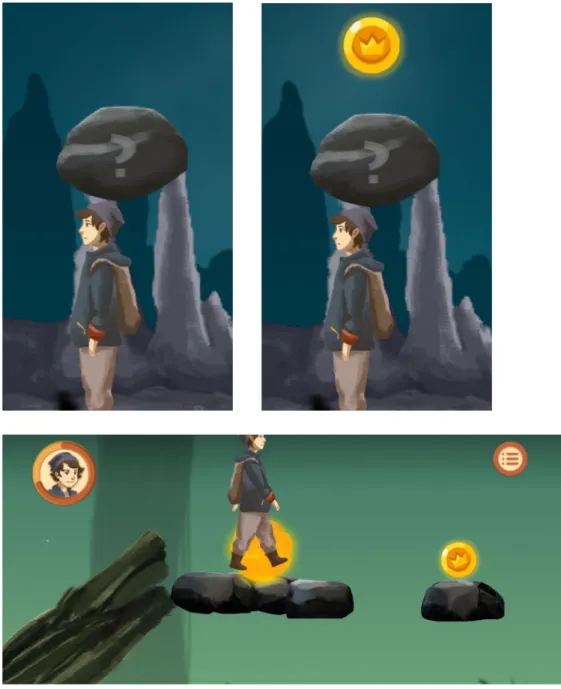Wearable Wonderland: Using Interaction Design
and Wearable Technology to Motivate People to
Stay Active
Xi Yang
xy7700@rit.eduFollow this and additional works at:
http://scholarworks.rit.edu/theses
This Thesis is brought to you for free and open access by the Thesis/Dissertation Collections at RIT Scholar Works. It has been accepted for inclusion in Theses by an authorized administrator of RIT Scholar Works. For more information, please contactritscholarworks@rit.edu.
Recommended Citation
Xi Yang
A Thesis Submitted in Partial Fulfillment of the
Requirements for the Degree of Masters of Fine Arts
in Visual Communication Design
Rochester Institute of Technology
College of Imaging Arts and Sciences
School of Design
Rochester, NY
May 20, 2016
Wearable Wonderland
Wearable Wonderland:
Using Interaction Design and Wearable Technology to Motivate People to Stay Active
Xi Yang
May 20, 2016
Thesis Committee Members: Chief Thesis Adviser:
Chris Jackson, MFA Visual Communication Design
Associate Thesis Adviser:
Shaun Foster, MFA Visual Communication Design
Associate Thesis Adviser:
Daniel DeLuna, MFA Visual Communication Design
Administrative Chair:
Peter Byrne, MFA Visual Communication Design
MFA Thesis Candidate:
Xi Yang
Title
Submitted by Date
Abstract
1.1 Situation Analysis
1.2 Problem Statement
2.1 Game Design Theory
2.2 User Experience Design
2.3 Wearable Technology
2.4 Designs for Healthy Lifestyle
2.5 Point-and-Click Puzzle Adventure Games
3.1 Approach
3.2 Target Audience
3.3 Mind Map
3.4 Game Design and Implementation
3.4.1 Game Concept, Story, and Rules 3.4.2 Flowchart and Wireframe
3.4.3 Game Environment Design
3.4.4 Game Characters & Objects Design 3.4.5 Intro Animation
3.4.6 Game Interface Design 3.4.7 Interaction Design
3.5 Prototype Development
3.5.1 Game Environment 3.5.2 Animation
3.5.3 Inventory System
4.1 Usability Testing
4.2 The Solution and Conclusions
Appendix Bibliography
Contents
Section 1 Introduction Section 2Review of Literature
Wearable Wonderland is an interactive game about a boy's wonderful journey. The game is a mobile app that works with wearables. The goal of the thesis is to promote a healthy lifestyle using wearable technology. The target audience is young people who want to build a healthy lifestyle and become more active, ranging from ages 18 to 30.
Staying active and maintaining enough sleep is important to one’s overall wellbeing. Today, many fitness trackers and fitness apps have appeared on the market to encourage doing exercise. They can track people's activities easily. However, most of these apps cannot engage users over a long period of time because these apps cannot motivate users.
The mission of this project is to help people establish an exercise routine while they are playing an engaging game. The thesis project is an iPad sized web-based interactive prototype that simulates one level of the game.
Keywords:
Game design, User experience, Interactive design, Wearable technology, Fitness
Introduction
Physical activity benefits both body and mind; it can also help combat stress and potential illness. However, exercising can often be the last thing on young people’s To Do lists. There are a number of reasons why young people do not want to do exercise. One main reason is they always start out with big and difficult goals, like “I’m going to work out for one hour a day!” “I want to lose 20 Pounds in a month”. As a result, they can only maintain their exercise plans for first few days, and then they will soon become tired of it. Actually, exercise is not that hard. People can take advantage of all the opportunities to get active: shop around, climb stairs, and walk a short distance instead of a ride in a car.
Another reason why it’s hard to establish an exercise routine is that many people find exercise boring. It’s difficult for them to keep doing exercise day after day. Today, many fitness trackers have appeared on the market to encourage a person to stay active. Trackers can simply track people’s walk steps, sleep status, and calculate the burned calories. Usually, these trackers have related apps to report users’ daily activities. The initial level of enthusiasm for fitness trackers typically fades quickly due to a lack of motivation in the apps. Most of the fitness apps today only provide information. A study shows that beginners really want to get their progress visualized in numbers. Users like to know how well they are doing while running. So users like to use fitness trackers which can log those data automatically, but they will lose interest in using these trackers quickly because they can't find the usage of these data.
In this case, a game may make the data useful because a game can provide rewards to players. An effective reward system is the essential component of a game. Creating a story for a game is also very important. The longer a person walks, the further he/ she moves forward into a story. In addition, research shows that a good way to stay motivated in a fitness program is to work out with someone else.[1] Many users like to
share their achievements with other users, because they wanna get compliments and encouragements from others. The rewards system and story are external motivation, which can also help to increase internal motivation. Research has shown that habits can be formed by completing a task for 21 days in a row.[2] After people become more
used to exercising, they feel they are in better shape. They start to enjoy exercising and would keep exercising without the game.
Cockcroft, Lucy. "Exercising with a friend 'helps to lose more weight'". http://www.telegraph.co.uk/health/ Maltz, Maxwell. Psycho-Cybernetics, A New Way to Get More Living Out of Life, Pocket Books, 1989, 8. [1]
This thesis is a prototype of an interactive game that motivates users to be active by turning steps into a reward system or energy levels in a game. This game will use wearable devices to detect and record users’ walking steps, exercise time, and their sleep hours, allowing users to count their daily steps, help them level up in the game, and give them a motivation to keep doing exercise.
What makes the interactive game unique is that it encourages users to stay active using graphic design, motion graphics, and interaction design. The research included game design, illustration design, interactive design, and fitness information related to young people, aiming to answer the following questions:
Do people understand the value of staying active?
What are some of the factors that can motivate a person to participate in an activity? What have other companies done in the field of physical fitness and what can I learn from them?
Why do people continue to or stop using these fitness products?
How can gamification help to encourage people to keep doing exercise? What style of characters can be created to make the game more engaging? •
• •
Survey of literature
Chris Crawford on Game Design
By Crawford, Chris.
DERSON, December, 2002.
In this book, the author shares the history of game design, shows lots of examples of classic games and analyzes their merits and faults. Through this information, readers can learn the foundational skills behind the design and architecture of a game. Before determining what the game will look like, human behavior and user experience should be analyzed. He also lists several common mistakes people make when trying to make games which can help beginners to avoid making these mistakes.
Chris Crawford on Interactive Storytelling
By Crawford, Chris. New Riders Games, 2004.
This book provides a new pattern of thinking for readers. For an adventure game, the story behind the game is very important, awesome graphics and great gameplay is not enough. in this book, readers can find examples of contemporary games that rely on different technologies and learn the storytelling lessons to be garnered from each of the past methodologies.
100 Principles of Game Design
Edited by Wendy Despain New Riders, 2013
The design questions and principles in this book are collected from every popular school of thought in game design. This book is divided into four themes: innovation, creation, balancing, and troubleshooting, and also serves a wide range of design experience. Beginners can use it to learn the basic knowledge before diving into those deeper books.
Level Up! The Guide to Great Video Game Design
By Rogers, Scott
John Wiley & Sons, Ltd., 2014
This book teaches beginners how to create a game step by step, it focuses on how to design a game strategy and game rules. The author can explain complex principles in simple ways. He also discusses some details of how to design a game, like how to write the story behind the game and what kind of movement the video game character can do.
Measuring the User Experience
By Tullis, Thomas.
Morgan Kaufmann, 1 edition, July 27, 2010.
In this book, the author shares his vast experience to teach people how to do usability testing and how to gather usability metrics without busting the budget. It shows all the best practices and methods for collecting, analyzing and presenting metrics for usability evaluations from all the best sources.
Designing Interactions
By Moggridge, Bill.
The MIT Press; 1 edition, October 1, 2007.
This is not a book focus on game design. But from this book, readers can know how the technology of interaction came into being and how it will advance in the future. This is a history book of interaction and product design. It uses interviews with many of the most influential and important people and their stories in interaction design.
Wearabledevices.com
http://www.wearabledevices.com/devices/
This is a website which helps people discover the latest wearable technology. People can learn the newest research, basic theory and device analysis from this website. This website will let people have a comprehensively understanding of this new technology.
User Experience Design
Designing for Wearable Technology
By Kennedy, Sinead
https://medium.com/ui-collection/designing-for-wearable-technology-67e8e24073a9
Design for wearable technology is a subject which integrates UX/UI design, interaction design and Product Design. Through analyzing the trend of design and wearable devices, the author shares some opinions about how to apply traditional design principles to wearable devices.
Game Design Principles in Everyday Fitness Applications
By Campbell, T., Ngo, B., & Fogarty, J.
Proceedings of the ACM 2008 Conference on Computer Supported Cooperative Work (San Diego, CA, USA, November 08 - 12, 2008).
Through analyzing several successful games which focused physical interaction, the authors examine a game design literature. Then they use these principles to analyze existing applications and design a game Kukini. From this article, readers can know how these existing fitness applications work and know how to do a research before start to design.
Let's play!: mobile health games for adults
By Grimes, Andrea, Kantroo, Vasudhara & Grinter, Rebecca
Proceedings of the 12th ACM international conference on Ubiquitous computing Pages 241-250
The authors created OrderUP!, a game which players learn how to make healthier meal choices. Through learning their design process, readers will recognize that well-designed casual mobile games can really help adults learn how to live healthfully. From their report, readers can also know the pros and cons of those existing health games.
Tiny Thief
Developed by 5Ants
Tiny Thief is a point-and-click adventure game, the goal of the game is to steal a certain object placed in an area of the level. Players may guide the thief into different areas, and let the thief pick up objects to help with the mission. However, if a guard sees the thief, the level will restart at a certain point.
The Lost City
Developed by Fire Maple Games
The Lost City is a puzzle adventure game with a strong background story. In this game, all the users have to do is tap around to investigate and explore. Users usually get an obvious visual indicator of someplace that has something to tap on. Items are stored in a bag system, then users can open the bag to access items and use them to solve problems.
Drawn
Developed by Big Fish Studios
Drawn is an adventure game series, with puzzle-solving elements. It has beautiful illustrations and diversified story plots. Users need to find hidden objects from the game environment and use them in correct ways. There are also a variety of mini-games scattered throughout the main adventure, ranging from simple title puzzles to more complex number dial puzzles.
Hiversaires
Developed by David Mondou-Labbe
Hiversaires is a first-person point-and-click, or "escape" type game in black-and-white tones. It's a textless game. There are no menus, no inventories, and no clues. At the beginning, users don't know where they're supposed to go, or how to get there. The only thing they can do is to discover everything and figure things out piece by piece.
Point-and-Click
Unity Professional Development From A to Z
Instructed by Ahmad Naser
https://www.udemy.com/unity3d-professional-2d-game-development-from-a-to-z/ learn/v4/overview
It is an online course published in Udemy, it's a complete project-based process to build a complete 2D game using Unity3D. In this course, the instructor cover everything related to the design and development for games.
Unity Manual
http://docs.unity3d.com/Manual/index.html
The Unity Manual is an official tutorial from Unity3D. It helps people learn the basic knowledge about how to use the Unity Editor and its associated Services. It can also be used as an online tech dictionary.
Unity 2D Platformer Tutorial - Learn The Basics Of Making A Game!
https://www.youtube.com/watch?v=86Bgt--Ww7w&list=PLiyfvmtjWC_ Up8XNvM3OSqgbJoMQgHkVz&index=2
This is a video tutorial series to teach people how to use Unity3D to develop a completed simple 2D RPG adventure game. From how to control the movement of the character to how to add enemies, from how to create parallax scrolling backgrounds to how to set up a health bar. The thesis candidate learned a lot of practical knowledge of how to develop a RPG game step by step from the videos.
Study and analyze people's lifestyle, and what is a healthy lifestyle. Research the existing fitness products and wearable technology. Design the story, rules, background and characters of the game. Create an interactive prototype.
Perform usability testing and collection of feedback. Evaluate and revise the game.
The Wearable Wonderland is a game for mobile devices, specifically an iPad. The design purpose was to use engaging gamification and interactive elements to help people establish an exercise routine.
The design process included following areas: study and analyze the existing video and mobile games and establish complexity of game structure. The game should offer interesting and varied gameplay experience; apply interface design and interactivity cues, the game illustrations have to be engaged and the user interface have to be simple and easy to operate; evaluate and modify the design to improve the game. The elements of the design included game characters, game environment and game UI.
Based on the limitation of the techniques, the final design product was
an iPad sized web-based interactive prototype of the game. All the illustration assets were designed in Adobe Photoshop, the prototype was created by Unity 3D.
Mind Map
Figure 1 Mind Map
Reasons People Don't Exercise A busy schedule
Exercise is painful
Previous failed exercise experience
Can not see obvious results rapidly
Exercise is boring
Limited budget
Good Game Design Analysis Easy to learn
Match players' abilities, not too easy or too hard
Multiple options or routes to complete a task
Encourage players by giving them rewards
After doing research on different kinds of games, a Point-and-Click puzzle adventure game was chosen for the thesis project. The point-and-click adventure game is a part of traditional adventure games which players use their mouse and keyboard to interact with the environment, solve puzzles and have conversations with different characters.
This kind of games would include a list of hints to describe specific actions or items in the manner of a text adventure. Often, in these games, players need to collect items and put them in character's inventory, then figure out how to use these items; the player would need to find and use clues from the game environment and other non-player characters. In addition, completing each puzzle in the game will unlock more of the game levels to explore, additional puzzles to solve, and expand the game's story.
The narrative of this game is about a boy's journey into a fictitious wonderland. His adventure starts from a forest. He will meet several unusual creatures during his adventure. The main mission of the game is to help him find all hidden objects and use these objects to collect all monsters in this magic world.
Game Concept
Story
Rules
Reward system
Walking Steps Energy (1000 maximum) (10 Steps = 1 Energy) Exercise(Running) Time 2 Minutes = 1 Coin
Sleep hours Stars (10 maximum per day) (1 Hour = 1 Star)
Coins / stars Tools Help the main character to clear obstructions and achieve the missions.
Food Feed monsters or replenish the main character's energy.
Users can also find hidden objects from the environment.
The steps which are recorded from wearable devices will be turned into coins or energy in the game to help the game character continue his journey and explore other new creatures.
There is also a night mode as the players sleep. After players wake up, they can gain different rewards based on their sleep hours.
•
•
•
•
•
Flowchart
Figure 2 Flowchat
Home Page
New Story Continue
For new players or players who want to reset the game
For return players to load their saved game progress
Intro Animation
Show players the background story of the game
Instruction
Introduce how to connect trackers to the game
Daily Rewards
Sync activity status into energy/coins/ stars in the game
Level 1
Explore the game environment to collect hidden items; Chat with NPCs to get important clues
Next Level
Wireframe Figure 3: Wireframe: Homepage Figure 4 Wireframe: Intro animation Figure 5 Wireframe: Instruction 1 3 4 Homepage
Players can start a new story or continue their journey to explore a different story.
click to go to figure 4. click to go to figure 5.
Intro Animation
show the background story of this game. Click to keep reading the story.
Click to skip the story, go to the figure 5.
Instruction
Show how to connect trackers to the game, and how to transfer activity status to the reward system in the game. Click to go to the figure 6. 2 3 2
New
Continue
1 2 5Skip
Next
3 43
4
Rewards
Sync activity status into the game, transfer walking steps, exercise minutes, and sleep hours into energy, coins, and stars.
Click to go to the figure 7.
Level 1
Energy Bar
Show how much energy the character remains, the energy is decreasing slowly when the player is playing the game.
Dropdown Menu
Includes: Map, Monster Manual, Bag, Help, and setting page.
Map
The player can go to any unlocked places. 6 6 7 7 8 8 Figure 6 Wireframe: Rewards Figure 7 Wireframe: Main Game Scene
Figure 8
Monster Manual
All collected monsters can be found on this page.
Bag
All collected items can be found on this page.
Setting
Yul: he is the main character of the game, players need to use the keyboard to
control his movement.
Hermes: the cat is the guide for this game. After chatting with him, players can click
the chest next to him to get a bottle of magic water.
"Hey Yul! I'm Hermes. Welcome to Axis Mundi! I summoned you here from your world. You have some special characteristic, which makes you stand out from other people. Before you start your adventure, I wanna give you some advice. Making friends with the creatures here is important to you, they may give you gifts or helpful hints. Also, you need to explore this area and try to find all hidden objects. I have a gift for you, please check out the chest. Good luck!"
Game Characters & Objects Design
Figure 12
Main Character Design
Figure 13
Sweet Sprout: players need to use magic water to cure this sprout.
"Help...help me please...I am feeling terrible...I'm going to die soon..."
This is a series, players need to unlock these three animals step by step.
Payton: a light gray baboon who like bananas. Kiki: a monkey who like peaches.
"Do you wanna rescue this poor monkey? If you can give me a peach, I could consider to put him down"
Charlie: a monkey hanging on the tree. "Put me down!"
Figure 14
NPC Character Design: Sweet Sprout
Figure 15
Root: "I can't stop erupting. I guess it's because I mistook a red diamond yesterday." Seed: "Fire! Fire! Fire!"
Elsie: a water fairy, she will give a request to Yul.
"I need some crystals to decorate my palace. Can you help me collect five crystals? I'll appreciate it."
Avery: a fire fairy, she is the owner of the red diamond.
"Oh no, I lost my spirit diamond!"
Figure 16
NPC Character Design: Root and Seed
Figure 17
NPC Character Design: Elsie
Figure 18
Merlin: a plant fairy. "Water is the essence of life."
Merchant: players can buy food and tools from his store.
Mushroom: he can help Yul jump higher.
Figure 19
NPC Character Design: Merlin
Figure 20
NPC Character Design: Merchant
Figure 21
Game Environment
Figure 22
Game Environment: Forest 1
Figure 23
Game Environment: Forest 2
Figure 24
Figure 25
Game Environment: Cave 1
Figure 26
Game Environment: Cave 2
Figure 27
Since the whole story happens in a wonderland, it's better to add some mythological elements in the game. In addition, a solid and attractive story is important for a puzzle adventure game. A background story about the Greek goddess Gaia was created for the game, to explain why the main character was summoned from our human world to this magic world.
Gaia, along with Chaos and Eros, coexisted during the creation of the world. Gaia was a primal Greek goddess, one of the deities that governed the universe before the Titans. She symbolized the Earth, and was the mother of everything.
In order to worship Gaia and pray for a peaceful world, the ancients built a shrine of Gaia in Axis Mundi, which is treated as the center of the world, the connection between Heaven and Earth.
Intro Animation
Content
Figure 28 Intro Animation 1
However, a thousand years later, two races fought each other because of a power struggle. People's peaceful life was devastated, and the shrine was also destroyed in this war.
The world was descending into Chaos. Many evil spirits and variations appeared in this area. The creatures needed a hero to rescue them. Then, a boy from our human world was summoned to this place.
Figure 30 Intro Animation 3
During the whole design process, designing an effective game UI is a pretty important and challenging part. Poor UI design can even break the game completely.
User interface design in games differs from other non-leisure application UI design, such as web UI design and mobile app UI design. The main mission of those non-leisure application UI design is to show the function and the flow of the product. Their interface will lead users to achieve a specific goal, like create a travel plan, finish a purchase, and find a nearby restaurant. However, a good game UI design should not only provide users a good usability, but also provide a positive affect, which means the UI design need to engage users and attract them to keep
playing the game. It's also important to make a good balance between the game UI and the game illustration. The user-friendly interface needs to show the functions clearly, and have the same style with the illustration.
There are two options for different players. For return players, they can click Continue button to load their saved games. For new players or players who want to reset the game, they can click New Story to start a new game.
The homepage is animated to create a mysterious atmosphere for the game. At the beginning, the title and buttons are hidden behind trees and herbs, then the title appears while the scene is zooming. Since all the game illustrations use this brush style, the same visual style was chosen to decorate the title and buttons. Fog and dust particles were also added to simulate a natural scene.
Game Interface Design
Part 1 Home Page
These two pages show players what is the connection between the fitness trackers and this game, and how to transfer their activity status into a reward system in this game.
Instead of using a large paragraph of text, some icons and an infographic were created to express the idea, which could express the concept in a simple and clear way.
Part 2
Instruction Pages
Figure 33 Instruction 1
The game will transfer player's activity status into the reward system automatically. The maximum capacity of energy bar is 1000. Two different colors were used to distinguish the new energy and the remained energy. The light orange stripe represented the new energy, and the dark orange stripe represented the remained energy.
Part 3
Daily Rewards
Figure 35 Daily Rewards 1
User testing was done during the UI design process. And the game UI was revised several times based on users' feedback. In the previous version of this energy bar, there was a hidden panel, which could appear after the player clicked the portrait of Yul. In the refined version, the panel was deleted and the energy bar was added on the portrait. This revision reduced the control operating steps and made the interface look simpler and clearer.
Part 4 Energy Bar
Figure 37 First Version of Energy Bar
Figure 38
Even though the main mission of UI design is to create a clean and simple interface, but the style of icons in the first version was pretty different from the game illustration. These icons looked rigid and mechanized. So the icons were recreated to match the illustration style.
Part 5
Dropdown Menu
Figure 39 First Version of Dropdown Menu
Figure 40
In this page, players can go to any unlocked levels via simply click different areas.
At the beginning of the game, there were instruction pages after the intro animation to introduce the game rules. However, some players might forget the details of the rules later, so a help page was created, which can be found from the dropdown menu. Players could learn how to control the game quickly and easily from this page.
Part 6 Map
Figure 41 Map
Part 7 Help Page
All the collected monsters will be put in the monster manual. After the player collects all the monsters in this level, the next level will be unlocked. In the revised version of this page, the shape of the slots were changed to make this page look more dynamic. In the meanwhile, some hints of which monsters can be unlocked were given to players.
Part 8
Monster Manual
Figure 43 First Version of Monster Manual
Figure 44
In the revised version of this page, the biggest change is to relocate the bag menu on the bottom. It's easier for players to drag and drop an object to a target. Also, the shape of the slots were changed and simplified. In the revised version, players can drag the scroll bar to view all items they collected.
Part 9 Bag
Figure 45 First Version of Bag Page
Figure 46
The same revisions were made on this screen as the Bag screen. The shape of these slots were also revised for consistency. Since all the objects are in a realistic illustration style, players can recognize them easily. The names of all objects were removed to simplify the interface.
Part 10 Shop
Figure 47 First Version of Shop Page
Figure 48
Players can know how much energy, how many coins and how many stars they have from this page. Players can also click the Exit button to go back to the home page.
After rescuing a monster, this page will pop up and show the name and avatar of the monster. If the monster gives some gifts to the main character, players can also get a hint from this page.
Part 11 Setting Page
Figure 49 Setting Page
Part 12
Unlocked Page
Figure 50
The interaction design of the game focuses on how to tell users what to do and make sure they are in the right direction. The main elements of interaction design in a point-and-click puzzle adventure game are "hints" and "feedback".
There are two different ways players can do to interact with the game environment. The first way is to press the "spacebar" key. Players can press "spacebar" to chat with other non-player characters, and press "spacebar" to switch scenes. Chat bubble shaped icons were placed next to the characters/objects where players need to use the “spacebar" key to interact with them.
Interaction Design
Figure 51 Dialogue Box
Another way to interact with the game environment is to click the mouse button to collect items. The clickable items are highlighted and look a little different with other normal items. Besides the highlights, there are some text hints and feedback in the game.
Figure 53 Clickable Items
Floating coins were added that the players can collect to add more of a challenge and interesting gamification of the story. Players need to explore the environment to find useful tools or effective methods to collect those coins.
Figure 55 Bonus Stone
Screenshots
Figure 57 Screenshot 1
Figure 59 Screenshot 3
Figure 61 Screenshot 5
Instruction Part 1 Game Environment Figure 63 Unity Workplace Figure 64 Parallax Scrolling Background
Prototype Development
After doing research on different game engines, Unity's new 2D workflow was chosen to develop the prototype, which required C# for programming. Using Unity to create an interactive prototype was challenging as the thesis candidate was new to this game engine. Fortunately, tutorials assisted in developing all the features used in this game. Also, there are many online courses in Udemy that teach all the aspects of Unity. Some of the technical challenges encountered while developing this game are listed below.
A parallax scrolling background was created which was a simple and effective way to create the illusion of depth in a 2D game. The scene was composed of four layers, one foreground layer, one player object layer and two background layers. The player objects exist on top of layer 2. This layer was the focal point of the user and dictated the speed of the background and foreground layers.
There were two different game environments in this level, both of these two
environments were used the same scene. Players can switch the position from one environment to another quickly via a teleporter.
Part 2 Animation
Figure 65 Walk Cycle
Figure 66 Animator
Part 3
Inventory System
Figure 67
Inventory System Flowchat
Figure 68
Inventory System Controller
There was continuous usability testing throughout the development of this game. It was very helpful in improving this thesis project. The objective of testing is to test the first time user experience and whether new users understand the controls, interface, gameplay elements and hints.
The main method employed for the user testing is the face-to-face observations of user interaction. Observing people playing this game illustrated where the problems were and how they could be improved. Special attention was given to when users stopped and tried to figure out what was the next step.
The improvements made based on the usability testing are as follows: Changed some content scripts which might mislead players.
Added hints for the first clickable object and the firstnon-player character, which gave new players a better understanding of how to control the game. Changed some icons and symbols to make them easier to recognize. Did some illustration twists.
Fixed some technical bugs.
Many users also provided some great advice and new ideas for the further development of the game. The further steps of the project are focusing on the following aspects:
Add animation to non-player characters.
Add audio or background sound to improve user engagement. Keep creating new stories and levels, and add some side missions.
Add more exercise concepts in the game to encourage people to do more exercise, such as set a treasure chest which can only be open if the player walks more than 10000 steps in one day.
Conclusion
In conclusion, Wearable Wonderland is not a very nerve-racking game, unlike many adventure games or action games, no characters will be killed in this game, but it doesn't mean it's a non-challenging game. If players want to collect all the monsters and unlock all the levels in this game, they need to be discerning to find all the hidden objects, and they need to have a connective thinking, knowing how to solve problems step by step.
After usability testing, users provided great feedback for this game. The visual style is engaging and attractive, the story and interactive elements are effective.
Most users really want to use this game to build an exercise routine, and look forward to the new levels and new stories.
The Wearable Wonderland game provided a better experience about visual design and interaction design. Through the process of designing and developing
Original Thesis Proposal Code Sample
Appendices
public Transform[] backgrounds; private float[] parallaxScales; public float smoothing = 1f;
private Transform cam;
private Vector3 previousCamPos;
void Awake () {
cam = Camera.main.transform; }
void Start () {
previousCamPos = cam.position;
parallaxScales = new float[backgrounds.Length]; for(int i = 0; i < backgrounds.Length; i++){ parallaxScales[i] = backgrounds[i].position.z * -1; }
}
void Update () {
for (int i = 0; i < backgrounds.Length; i++){
float parallax = (previousCamPos.x - cam.position.x) * parallaxScales[i]; float backgroundTargetPosX = backgrounds[i].position.x + parallax; Vector3 backgroundTargetPos = new Vector3(backgroundTargetPosX, backgrounds[i].position.y, backgrounds[i].position.z);
backgrounds[i].position = Vector3.Lerp (backgrounds[i].position, backgroundTargetPos, smoothing * Time.deltaTime);
}
previousCamPos = cam.position; }
Code Sample Sample 1:
public class CameraController : MonoBehaviour { public bool FollowsPlayer{get;set;}
[Space(10)]
[Header("Dimension")]
public bool Camera3D = false; [Space(10)]
[Header("Movement Speed")] public float ResetSpeed = 0.5f; public float CameraSpeed = 0.3f; [Space(10)]
[Header("Camera Zoom")] [Range (1, 20)]
public float MinimumZoom=5f; [Range (1, 20)]
public float MaximumZoom=10f; public float ZoomSpeed=0.4f;
protected Transform _target; protected float _xMin; protected float _xMax; protected float _yMin; protected float _yMax; protected float _offsetZ;
protected Vector3 _lastTargetPosition; protected Vector3 _currentVelocity; protected Vector3 _lookAheadPos; protected float _shakeIntensity; protected float _shakeDecay; protected float _shakeDuration; protected float _currentZoom; protected Camera _camera;
protected Vector3 _lookDirectionModifier = new Vector3(0,0,0);
protected virtual void Start (){ _camera=GetComponent<Camera>(); FollowsPlayer=true;
Code Sample Sample 2:
_currentZoom=MinimumZoom;
_target = GameManager.Instance.Player.transform;
if (_target.GetComponent<CorgiController>()==null) return;
_targetController=_target.GetComponent<CorgiController>(); if (LevelManager.Instance!=null){
_levelBounds = LevelManager.Instance.LevelBounds; }
_lastTargetPosition = _target.position;
_offsetZ = (transform.position - _target.position).z; transform.parent = null;
Zoom(); }
protected virtual void FixedUpdate (){ if (!FollowsPlayer)
return; Zoom();
float xMoveDelta = (_target.position - _lastTargetPosition).x;
bool updateLookAheadTarget = Mathf.Abs(xMoveDelta) > LookAheadTrigger; if (updateLookAheadTarget) {
_lookAheadPos = HorizontalLookDistance * Vector3.right * Mathf. Sign(xMoveDelta);
} else {
_lookAheadPos = Vector3.MoveTowards(_lookAheadPos, Vector3.zero, Time.deltaTime * ResetSpeed);
}
Vector3 aheadTargetPos = _target.position + _lookAheadPos + Vector3. forward * _offsetZ + _lookDirectionModifier + CameraOffset;
Vector3 newCameraPosition = Vector3.SmoothDamp(transform.position, aheadTargetPos, ref _currentVelocity, CameraSpeed);
Vector3 shakeFactorPosition = new Vector3(0,0,0); if (_shakeDuration>0) {
shakeFactorPosition= Random.insideUnitSphere * _shakeIntensity * _ shakeDuration;
_shakeDuration-=_shakeDecay*Time.deltaTime ; }
newCameraPosition = newCameraPosition+shakeFactorPosition;
Code Sample Sample 2:
if (Camera3D==false) { float posX,posY,posZ=0f;
if (_levelBounds.size != Vector3.zero){
posX = Mathf.Clamp(newCameraPosition.x, _xMin, _xMax); posY = Mathf.Clamp(newCameraPosition.y, _yMin, _yMax); } else {
posX = newCameraPosition.x; posY = newCameraPosition.y; }
posZ = newCameraPosition.z;
transform.position=new Vector3(posX, posY, posZ); } else {
transform.position=newCameraPosition; }
_lastTargetPosition = _target.position; }
protected virtual void Zoom() {
float characterSpeed=Mathf.Abs(_targetController.Speed.x); float currentVelocity=0f; _currentZoom=Mathf.SmoothDamp(_currentZoom,(characterSpeed/10)*(Ma ximumZoom-MinimumZoom)+MinimumZoom,ref currentVelocity,ZoomSpeed); _camera.orthographicSize=_currentZoom; GetLevelBounds(); }
protected virtual void GetLevelBounds() { if (_levelBounds.size==Vector3.zero) { return;
}
float cameraHeight = Camera.main.orthographicSize * 2f; float cameraWidth = cameraHeight * Camera.main.aspect; _xMin = _levelBounds.min.x+(cameraWidth/2);
_xMax = _levelBounds.max.x-(cameraWidth/2); _yMin = _levelBounds.min.y+(cameraHeight/2); _yMax = _levelBounds.max.y-(cameraHeight/2); }
Code Sample Sample 2:
public virtual void Shake(Vector3 shakeParameters) { _shakeIntensity = shakeParameters.x; _shakeDuration=shakeParameters.y; _shakeDecay=shakeParameters.z; }
public class DialogueZone : ButtonActivated { [Header("Dialogue Look")]
public Color TextBackgroundColor=Color.black; public Color TextColor=Color.white;
public bool ArrowVisible=true; [Space(10)]
[Header("Dialogue Speed (in seconds)")] public float FadeDuration=0.2f;
public float TransitionTime=0.2f; [Space(10)]
[Header("Dialogue Position")] public float DistanceFromTop=0; [Space(10)]
[Header("Player Movement")]
public bool CanMoveWhileTalking=true;
[Header("Press button to go from one message to the next ?")] public bool ButtonHandled=true;
[Header("Only if the dialogue is not button handled :")] [Range (1, 100)]
public float MessageDuration=3f; [Space(10)]
[Header("Activations")]
public bool ActivableMoreThanOnce=true; [Range (1, 100)]
public string[] Dialogue;
protected DialogueBox _dialogueBox; protected bool _activated=false; protected bool _playing=false; protected int _currentIndex; protected bool _activable=true;
public override bool CanShowPrompt(){
if ( (_buttonA==null) && _activable && !_playing ){ return true;
}
return false; }
protected override void OnEnable () { base.OnEnable();
_currentIndex=0; }
public override void TriggerButtonAction() { if (_playing && !ButtonHandled) { return;
}
StartDialogue(); }
public virtual void StartDialogue() { if (_buttonA!=null)
Destroy(_buttonA); if (_collider==null) return;
if (_activated && !ActivableMoreThanOnce) return; if (!_activable) return; if (!CanMoveWhileTalking){ GameManager.Instance.FreezeCharacter(); } if (!_playing){
GameObject dialogueObject = (GameObject)Instantiate(Resources. Load("GUI/DialogueBox"));
_dialogueBox = dialogueObject.GetComponent<DialogueBox>(); _dialogueBox.transform.position=new Vector2(_collider.bounds.center.x,_collider. bounds.max.y+DistanceFromTop); _dialogueBox.ChangeColor(TextBackgroundColor,TextColor); _dialogueBox.ButtonActive(ButtonHandled); if (!ArrowVisible) _dialogueBox.HideArrow(); _playing=true; } StartCoroutine(PlayNextDialogue()); }
protected virtual IEnumerator PlayNextDialogue(){ if (_dialogueBox == null) {
yield return null; }
if (_currentIndex!=0) {
_dialogueBox.FadeOut(FadeDuration);
yield return new WaitForSeconds(TransitionTime); }
if (_currentIndex>=Dialogue.Length) { _currentIndex=0; Destroy(_dialogueBox.gameObject); _collider.enabled=false; _activated=true; if (!CanMoveWhileTalking){ GameManager.Instance.CanMove=true; } if ((_character!=null)){ _character.BehaviorState.InButtonActivatedZone=false; _character.BehaviorState.ButtonActivatedZone=null; } if (ActivableMoreThanOnce){ _activable=false; _playing=false; StartCoroutine(Reactivate()); } else {
gameObject.SetActive(false); }
yield break; } if (_dialogueBox.DialogueText!=null){ _dialogueBox.FadeIn(FadeDuration); _dialogueBox.DialogueText.text=Dialogue[_currentIndex]; } _currentIndex++; if (!ButtonHandled){ StartCoroutine(AutoNextDialogue()); } }
protected virtual IEnumerator AutoNextDialogue(){
yield return new WaitForSeconds(MessageDuration); StartCoroutine(PlayNextDialogue());
}
protected virtual IEnumerator Reactivate() {
yield return new WaitForSeconds(InactiveTime); _collider.enabled=true;
_activable=true; _playing=false; _currentIndex=0;
Campbell, T., Ngo, B., & Fogarty, J., Game Design Principles in Everyday Fitness Applications, Proceedings of the ACM 2008 Conference on Computer Supported Cooperative Work (San Diego, CA, USA, November 08 - 12, 2008).
Crawford, Chris. Chris Crawford on Game Design, DERSON, December, 2002.
Crawford, Chris. Chris Crawford on Interactive Storytelling, New Riders Games, 2004.
Grimes, Andrea, Kantroo, Vasudhara & Grinter, Rebecca, Let's play!: mobile health games for adults, Proceedings of the 12th ACM international conference on Ubiquitous computing, 241-250
Kennedy, Sinead, Designing for Wearable Technology: https://medium.com/ui-collection/ designing-for-wearable-technology-67e8e24073a9
Moggridge, Bill., Designing Interactions, The MIT Press, 1 edition, October 1, 2007.
Rogers, Scott. Level Up! The Guide to Great Video Game Design, John Wiley & Sons, Ltd., 2014
Tullis, Thomas. Measuring the User Experience, Morgan Kaufmann, 1 edition, July 27, 2010.
